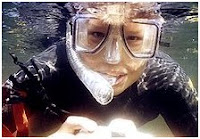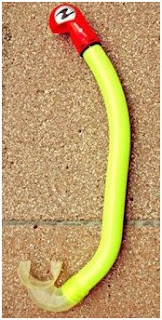A swimmer's snorkel is a tube
typically about 30 centimeters long and with an inside diameter of between 1.5
and 2.5 centimeters, usually L- or J-shaped and fitted with a mouthpiece at the
lower end, and constructed of rubber or plastic. It is used for breathing air
from above the water surface when the wearer's mouth and nose are submerged.
The snorkel usually has a piece of rubber that attaches the snorkel to the
outside of the strap of the diving mask. An older technique is pushing the
snorkel between the mask-strap and the head, but this practice increases the
chances the mask will leak.
Swimmers snorkel with splash guard
on top, but with no sump valve.
The optimum design length of the
snorkel tube is at most 40 centimetres (about 16 inches). A longer
tube would not allow breathing when snorkelling deeper, since it would place
the lungs in deeper water where the surrounding water pressure is higher. The
lungs would then be unable to inflate when the snorkeler inhales, because the
muscles that expand the lungs are not strong enough to operate against the
higher pressure.
Snorkels also constitute respiratory
dead space. When the user takes in a fresh breath, some of the previously
exhaled air which remains in the snorkel is recycled into the lungs, reducing
breathing efficiency and causing a build up of carbon dioxide in the blood,
which can result in hypercapnia. The greater the volume of the tube, and the
smaller the tidal volume of breathing, the more this problem is exacerbated. A
smaller diameter tube reduces the dead volume, but also increases resistance to
airflow and so increases the work of breathing. Occasional exhalation through
the nose while snorkeling will reduce the build up of carbon dioxide, as well
as helping to keep the mask clear of water.
Flooding
and clearing
The most common type of snorkel is a
simple tube that is allowed to flood when underwater. The snorkeler expels
water from the snorkel either with a sharp exhalation on return to the surface
(blast clearing) or by tilting the head back shortly before reaching the
surface and exhaling until reaching or breaking the surface (displacement
method) and facing forward again before inhaling the next breath. The
displacement method expels water by displacing its presence in the snorkel with
air; it is technique that takes practice but clears the snorkel with less
effort, but only works when surfacing. Clearing splash water while at the
surface requires blast clearing.
Snorkeler underwater, with snorkel's
sump valve apparent in foreground.
Some snorkels have a sump in the
mouthpiece to allow a small volume of water to remain in the snorkel without
being inhaled when the snorkeler breathes. Some also have a one-way output
valve in the sump, which automatically drains the sump as it fills with water.
A few snorkels have float-operated valves attached to the top end of the tube
to keep water out when a wave passes, but these cause problems when diving as
the snorkel must then be equalised, using part of the diver's inhaled air
supply. Some recent designs have a splash deflector on the top end that directs
any water that splashes over the open tube to the outside of the tube, thereby
keeping the tube relatively free from water.
A common problem with all assistive
mechanical clearing mechanisms is their tendency to fail due to infrequent use,
long periods of storage, and lack of maintenance, and also to fail due to
environmental fouling.
Natural rubber slowly oxidizes and
breaks down due to ultraviolet light exposure from the sun. It eventually loses
its flexibility, becomes brittle and cracks. This causes one-way clearing
valves to stick in the open or closed position, and float valves to leak water
due to a failure of the valve seat to seal out water. It is unlikely that
natural rubber is still used for any part of a snorkel. Silicone rubber is more
resistant to degrading and so tends to have a longer service life. Application
of a grease to the valve seats can aid in sealing, but this is mechanically
washed away over time, and a heavy grease can cause valves to stick closed and
trap grit, which will cause the valve to leak.
Environmental fouling can be caused
by beach sand or loose floating plant or animal matter getting lodged in the
valves and preventing proper opening or closing.
Although swimming with a snorkel is
much easier than without, it is important that a novice swimmer also learns
surface breathing and floating without a snorkel, in the event that these
assistive clearing mechanisms fail. If either the sump clearing valve sticks open
or the top float valve sticks closed, a snorkel is rendered useless as a
breathing aid and the swimmer is forced to fall back on alternative surface
breathing methods.
Some snorkels used to be made with
small "ping pong" balls in a cage mounted to the open end of the tube
to prevent water ingress, but these are no longer sold nor recommended to be
used since they are considered hazardous to the snorkeler. Similarly, diving
masks with a snorkel built into them are considered unsafe and obsolete.
The
dive mask
Snorkelers normally wear the same
kind of mask as those worn by scuba divers. By creating an airspace, the mask
enables the snorkeler to see clearly underwater. All scuba diving masks consist
of the lenses also known as a faceplate, a comfortable skirt, which also
encloses the nose, and a head strap. There are different styles and shapes.
These range from oval shaped models to lower internal volume masks and may be
made from different materials; common choices are silicone and rubber.
The
practice of snorkeling
Snorkeler with mask and snorkel.
Although donning a mask and snorkel
and swimming in any body of water would technically constitute
"snorkeling," by and large it is generally accepted that a
"snorkeler" would don such gear and practice such activity within the
vicinity of a reef, wreck, or other submerged objects, either to observe
aquatic organisms including fish, algae, etc. or to look at rock formations.
Being non-competitive, snorkeling is considered more a leisure activity than a sport.
Snorkeling requires no special
training, only the ability to swim and to breathe through the snorkel. However,
for safety reasons, instruction and orientation from a fellow
"experienced" snorkeler, tour guide, dive shop, or equipment-rental
shop is recommended. Instruction generally covers equipment usage, basic
safety, what to look for, and what to look out for, and conservation
instructions (fragile organisms such as coral are easily damaged by divers and
snorkelers). As with scuba-diving it is always recommended that one not snorkel
alone, but rather with a "buddy", a guide or a tour group.
Some commercial snorkeling locations
require snorkelers to wear an inflatable vest, similar to a personal flotation
device. They are usually bright yellow or orange and have a device that allows
users to inflate or deflate the device to adjust their buoyancy. However these
devices hinder and prevent a snorkeler from free diving to any depth.
Especially in cooler water, a wetsuit of appropriate thickness and coverage may
be worn; wetsuits do provide some buoyancy without as much resistance to
submersion. In the tropics, snorkelers (especially those with pale skin) often
wear a rashguard or a shirt and/or board shorts in order to help protect the
skin of the back and upper legs against sunburn.
Experienced snorkelers often start
to investigate amateur free-diving, which should be preceded by at least some
training from a dive instructor or experienced free-diver.
Safety
precautions
The greatest danger to snorkelers are
inshore and leisure crafts such as jet skis, speed boats and the like. A
snorkeler is often submerged in the water with only the tube visible above the
surface. Since these crafts can ply the same areas snorkelers visit, the chance
for accidental collisions exist. Sailboats and windsurfers are especially
worrisome as their quiet propulsion systems indicates that a snorkeler may be
unaware of their presence, unlike any motor-driven craft, as sound travels
farther underwater. A snorkeler may surface underneath one and/or be struck by
such vessels. Few places demarcate small craft areas from snorkelers, unlike
for regular bathers who may have areas marked by buoys. Snorkelers may
therefore choose to wear bright or highly reflective colors/outfits and/or to employ
dive flags to utilize being spotted easily by boaters and others. On the other
hand, some snorklers may use camouflage in order to surprise unsuspecting
visitors.
Snorkelers' backs can be exposed to
the sun for extended periods and can burn badly (even if slightly submerged),
without being noticed. Wearing appropriate covering such as a "rash
guard" (in warmer waters), a t-shirt, a wetsuit and/or sunblock will
mitigate the risk of sunburn.
Dehydration is another concern.
Hydrating well before going in the water is recommended, especially if one
intends to snorkel for several hours. Proper hydration also prevents cramps.
Snorkelers can experience
hyperventilation, which can lead in turn to “shallow water blackout″;
snorkeling with a buddy (and being aware of the buddy's condition at all times)
can help avoid this situation.
When snorkeling on or near coral
reefs, care must be exercised to avoid contact with the delicate (and sometimes
sharp and/or stinging) coral and its poisonous inhabitants, usually via
protective gloves and by being careful of one's environment. Booties and surf
shoes are especially useful as they allow trekking over reefs exposed by low
tide, to drop offs or deeper waters of the outer reef.
Also, for ecological reasons,
contact with coral always should be avoided because even boulder corals are
fragile. A soft touch can cause decades worth of growth to be undone in mere
seconds, and the coral may never recover.
Snorkeling
locations
Snorkelers observing fish in
Cozumel, Mexico.
Snorkeling is possible in almost any
body of water, but snorkelers are most likely to be found in locations where
there are minimal waves, warm water, and something particularly interesting to
see near the surface.
Generally shallow reefs ranging from
sea level to 1 to 4 meters (3 to 12 feet) are favored by snorkelers. Deeper
reefs are also good, but repeated breath holding to dive to those depths limit
the number of practitioners and raises the bar on fitness and skill level.
Source :
http://en.wikipedia.org/wiki/Snorkeling
Snorkel





Tidak ada komentar:
Posting Komentar